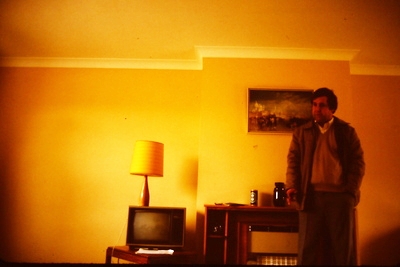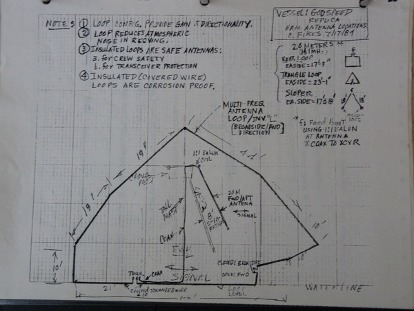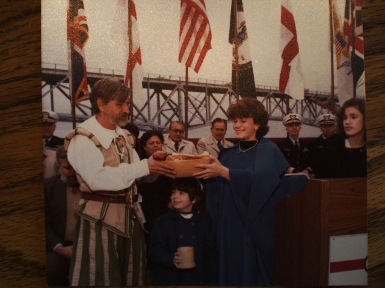The 1985 voyage across the Atlantic
Mike Lloyd writes:
"It was late in the year 1984 that I was 'resting'
(unemployed and broke!) when a friend told me of the forthcoming
'Voyage of the Godspeed' re-enactment and suggested that I may be able
to offer some assistance. I remember 2 interviews followed with John
Mossesson (then owner of Otley Hall, former residence of Bartholomew
Gosnold) and then a rather less formal chat (I'm sure it involved a
couple of pints of local Abbot Ale) with Howard Hull the overall UK
coordinator of the project. It was agreed that I would do my bit in
East Anglia whilst Howard looked after the London events, sponsorship
(mainly Willis Faber) etc. At that time I met up with Randall Bevan who
was then Director of Recreation and Tourism (or something similar) at
Ipswich Borough Council. Using his contacts and boundless enthusiasm
and my sales and marketing expertise (plus a pretty neat line in
begging!) we set about getting the show on the road.
In a fairly short time I managed to acquire a sponsored Mercedes
G-Wagon form our local dealer, an office ( a portakabin with a dreadful
gas heater that managed to produce seemingly gallons of condensation on
a daily basis), a disused warehouse which was cleaned up and used for
live performances and receptions, alcoholic beverages in some quantity
(used of course only for formal receptions (?!)), merchandise was
produced and franchised and all the myriad of items required to 'put on
the show' were begged and borrowed from very generous local businesses
and authorities.
Having been educated as a scientist my knowledge of Anglo-American
history was limited to a bunch of idiots throwing tea bags at each
other in Boston...Oh, and a bit about the Alamo (great movie!).. so I
found I had to do a bit of work and reading just to find out what all
the excitement was about.
 Godspeed Mobile Unit
Godspeed Mobile Unit
So, early in 1985 we had most of the infrastructure in place, all we
needed was the star of the show and and a gang of reckless souls who
apparently intended to sail this little vessel all the way back to
America. One fine day I found myself meeting this aforesaid gang with
support staff at Ipswich Station and transferring them to a house in
Ipswich which had kindly been lent by Willis Faber. I remember meeting
Neil Tanner the radio operator, Jack Greer the cook (whose ability to
beg borrow and otherwise acquire provisions and stores left me as a
rank amateur) Peter Meekins the sailing master (Peter and his wife
Caddy have remained firm friends from that day forward). Last but by no
means least I met up with Allan Libby who was doing my job (but
better!) on behalf of the American end of the project. We hit it
off on day one and have also remained firm friends to this day....
still with threats of getting together again one day to relive the
experience (with a small gin and tonic included). I remember many
others but regret the effects of Anno Domini havetaken their toll on
the old grey matter, so apologies to everyone else, they were all great
fun to be with.
 House in Ipswich
House in Ipswich
On a cold wet day in (sorry can't remember the date) we found ourselves
on the dockside at Felixstowe where a large container ship had
arrived and nestling between thousands of large boxes was our baby,
looking ridiculously small and obviously totally unable to sail to
America! Unloading took place and she was finally popped into the water
and with the help of local tugs was carefully taken round and moored in
the old Felixstowe dock basin. There then ensued a ridiculously busy
time as it seemed the whole world descended on the Godspeed to get her
ready, rigged, provisioned, equipped etc. She became a local star
and with local media involved, offers of help came thick and fast....
any job that needed doing, someone could do..or knew someone that
could. Great help was given by the Felixstowe Dock company and many of
the staff became unpaid, unofficial helpers.
 Mike
Lloyd
Mike
Lloyd
Lots more work, lots of functions later we had the pleasure of sea
trials, a few adjustments and then the time I had been building up
to... her arrival in Ipswich wet dock where she was to be on show for a
couple of weeks. A civic reception, a fly past, the crew all dressed up
in their authentic costumes followed by live events in the warehouse,
corporate events on board and in the Neptune Inn thousands and
thousands of local visitors, informal gatherings in the Malt Kiln;
Allan and I staffing the office all day and being involved in either
work or entertainment every evening. Sleep was put on hold for a while!!
After a hugely successful period in Ipswich the next stop was a
civic reception in Harwich (home I believe of Christopher Newport...
historic knowledge beyond that...zilch!). As a thank you to me from the
crew, my wife and children (then aged 11 and 9) were smuggled on board
early on the day of departure and had the privilege of sailing the
Godspeed down the River Orwell to Harwich for the reception there. I
believe my son Rob took the helm for quite a way (being 9 he was able
to see under the square sails quite happily so was ideal for the
job! Allegedly a speed in excess of 10 knots was achieved (maybe
just hearsay!) on the way to Harwich. On arrival the town had turned
out in numbers and the crew and local officials were paraded through
the streets on way to the reception. Afterwards, my family and I made
our way to the point where the River Orwell meets the North Sea as our
'baby' sailed past en route to London, taking with her my job, but
leaving me memories of probably the happiest 6 months of my life.
I only have limited knowledge of the London part of the programme as
apart from a couple of visits I was busy
unwinding things in Ipswich. We did attend the departure on 30th April
( The Duke of Edinburgh came too!).... lots of sadness as she sailed
off on her journey carrying my new friends into the wild blue
yonder.... Godspeed!
CLICK HERE TO READ WHAT ALLAN LIBBY WRITES
Chuck Fikes, W5CLE writes about the Amateur Radio support:
About the Jamestown station: 1. the transceiver, linear, and beam
antenna were loaned by members of the Richmond Ham Club(s). 2. The
Williamsburg Ham club supplied most of the station operators.
Claude
Feigley was the primary op and Gil Frey was a principal. Larry
Boellhoff was also a part as he was good at CW also. Gil called
on me
to debug the RFI problems (classic floating ground fix done by me) and
Claude and I figured out that the beam antenna was "off" by about 30
degrees (pointing too far South) because the guys who installed the
beam forgot that the steel in the Jamestown building roof influences
magnetic compasses. A check with my compass on the ground didn't
agree
with the pointing of the antenna. Claude had to "sweep" to get the
strongest signal and not trust the beam indicator meter. So we made the
correction and got good signal results! The linear ampl was mismatched
to the transceiver so only the 100 watt HF transceiver was used with
their beam antenna (3-Element, 3-band)

The Richmond Club might have photos of the station setup. This
was the
key station during the daytime and they were pleased to be in.
There
was a filming for a newscast by a TV station (Ch 3 ?) while the
Godspeed was under way. I don't know about the Jamestown Foundation
collection.
 HF Station at Jamestown
HF Station at Jamestown
Night time HF contacts were by the Williamsburg Ham club members.
Hayden Ross-Clunis (he might have names) did the nighttime contacts
from their home and used the Wmsbg club's 2-meter station to link
themselves to find your signal on 40 M. I got in on both as I was
making propagation forecasts. I insisted that we have two
scheduled
times a day as I did the HF commuications for Army's coastal going
watercraft based at Ft. Eustis, VA for about 8 years; they went as far
as the Panama Canal so I had that to help us. We really
needed that
second oppportunity for daily contacts!
The Godspeed system. The Williamsburg club wanted to do that.
The only
radio available was a kit donated by Heathkit. And we were short of
time; 30 days until the Oct. deadline to get it on the Godspeed. I had
experience building a Heathkit HF transceiver and doing wire-antenna
experiments for 80 M through 15 M so I volunteered myself into the
postition of chief builder of the transceiver and antenna for the
Godspeed. Heath Co. gave us a kit transceiver with power supply
and
antenna tuner.
 Radio
used during most of the trip
Radio
used during most of the trip
Building the 3 kits. Gil (Dentist and Ham)and his wife built
the power
supply, Randy Harris (Nasa Engineer and Ham) built the Antenna Tuner,
and I built the transceiver. My experience with aircraft and
ocean
going watercraft electronics in the Navy, in Dallas' Vought Navy jet
aircraft (Crusader) testing, TI, and Collins Radio aircraft
applications paid off because I saw and modified the 3 units with extra
cable tying, gluing, fastenings to make them more survivable for a sea
voyage. I enjoyed that work even though we were stressed to deliver.
The HF unit was all digital synthesis so it was very stable and
expected to be good for CW and SSB. I was glad that I had
been an
active Ham since 1953; W5CLE starting at US Navy Submarine Base, Pearl
Harbor, HI so that I could better understand your potential ocean
voyage problems.
The Godspeed's main HF antenna. You and I settled on the design of
the
insulated wire (no. 10 stranded copper) loop antenna and its attachment
to the Godspeed's rigging and masts as esthetically pleasing,
promised
HF signal benefits and safety from RF burns to crew aloft. Also you had
access to a 250 ft. roll of that wire. About 150 ft. of that wire
was
used to make the rectangular, vertical loop.
 Sketch
of proposed loop antenna
Sketch
of proposed loop antenna
I had been doing vertical loop experiments and Gil had been doing
horizontal loop experiments and as a result so did the Wmsbg Club
station that used the horizontal loop for Field Days and got great
results. So we had great hopes for multi-band HF communications on the
voyage of the Godspeed II. Dick McNutt was the pioneer of loops
in
2-meters.
 Final antenna design
Final antenna design
The initial try out of the Loop antenna-Antenna Tuner on the Godspeed
(at the Gloucester anchorage) made a big impression on Hayden/Ross so I
felt confident we had a winner of an antenna system. Remember Jas. Town
people didn't want any antenna to detract from the Ship's looks.
The
Antenna being a closed loop and insulated promised to be crew friendly
and it could cancel out the Russian "Woodpecker" radar that often
strayed into our Ham bands. Ross and his son climbed the rigging and
tied the wire as they climbed; some aerial acrobats!
While the Godspeed was at the Glouster anchorage we got some
directional tests (15 M station in the Caribbean) as the ship was being
turned about 180 degrees. The loop seemed to have a null of about 10
db. Such a null could help. The loop theoretically had 6 db gain and
would be a low noise antenna compared to a dipole antenna.
Looking
great for an antenna!
The power supply for the HF system: Marine batteries, a type well
proved by our Ham club's Field day experience; Gil Frey as the
Guru.
The charging systems candidates: a used NASA thermocouple (propane
powered) seemed to be too dangerous, I would have settled for a 500
Watt portable, but was delighted that one or two of the crew decided to
invest in a diesel powered generator. The diesel technology was
supportable anywhere on the voyage route. So glad you had a member
bring a beacon that could send a rescue signal
to the MARISAT (?) Maritime satellite! I was delighted to hear that
could be a part of the electronics package!
After your voyage some amazing news! Locally such a high
percentage of
daily contacts and so many were amazed at the ability to communicate
with CW and later with SSB.
Davenport, Iowa. I was there for gun testing for the Army
labs. I met
a Ham who said he made contact ( on 15 M ?) with the Godspeed. He
had a
rotatable loop (tall tower mounted) which he showed me. That may
be in
your log book. About a 1,000 more miles to your signal.
Also, during the voyage you said the loop was more reliable than the
commercial vertical that got installed late in the voyage (for a
commercial radio). The loop was the preferred HF antenna, the
vertical
had a lot of signal dropouts. When our MARS station in W. Germany
used
a triangle loop for its digital commo. it proved to be almost a
24/7
workhorse at 80 M linking the W. German MARS stations (1988-1991). The
Triangle loop fed by a length of coax. One of my helps for our Soldiers
as an active Army MARS member while I was an engineer there
(1986-1991). I had used our VA loop experiences again.
The area newspaper Daily Press gave daily coverage of the
voyage. That was really a team effort! Too bad
George Salley's radio
was so erratic but I think it got doused with a lot of sea water during
the voyage. I was hoping the Heathkit could be used from the
start of
the Voyage. You men did such a great job! Ham Radio and
sailing!
Amazing radio excepts "well sometimes you have to East to go
West." I
think that one was when you were off the Africa coast.
Quite a saga!
So glad you didn't try to sail in the Hurricane season from the
Caribbean to VA.
By the way, this Summer, I found that my paternal grand mother,
Rebecca Pace was a descendant of the Richard Pace of the Jamestown
Settlement. Another nice connection for us to the Jamestown
Settlement. The family mystery was finally solved by research
published on the Internet.
Gordon Kendrick writes:
"In
Late 1984 I made a wood bowl and cup for the Godspeed. It was later
presented to Captain Salley at a ceremony by Gov. Robs daughters (Pres.
Johnsons granddaughters). Another artist and I went on to make 100
wood commemorative cups that were to be given away along the voyage."


Please visit "Old
Ways Wood Works"
(the two photos above were provided by G. Kendrick)
This
site is still on the ways.
If you were part of the crew, email to: wa4chq(at)netscape.net